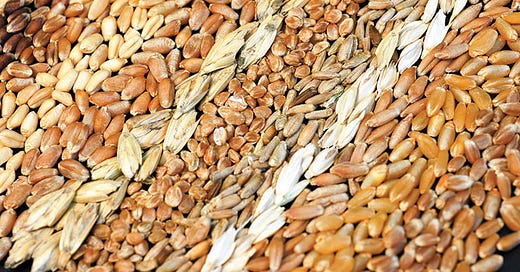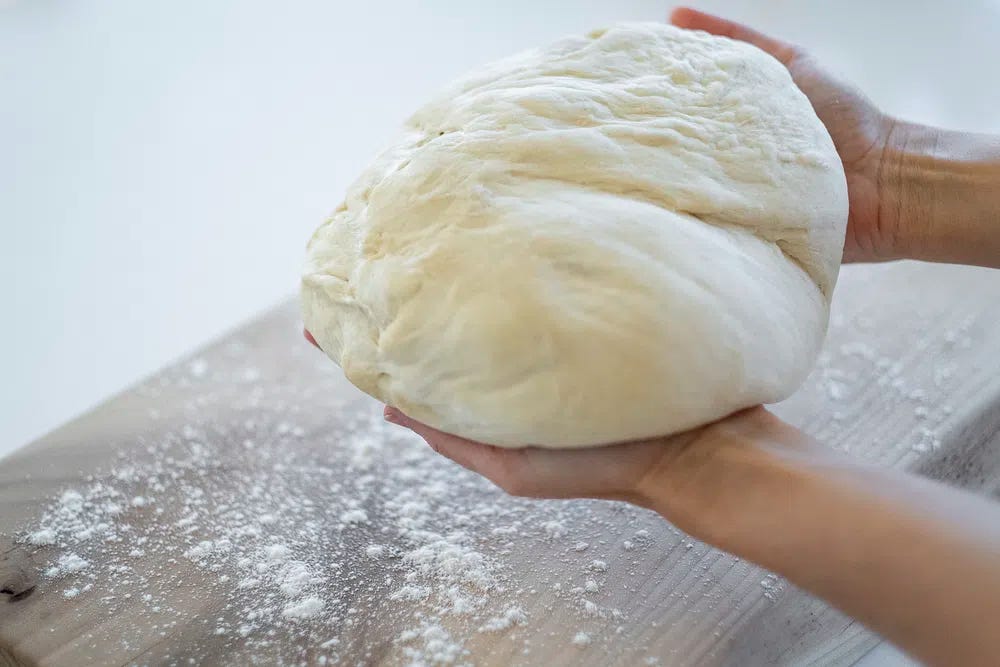Which grains contain gluten?
Gluten comes from the Latin word for glue to indicate its stickiness. Gluten is a protein composite found in the grains wheat, barley, rye and triticale (a cross between wheat and rye). Why only these 3 grains? You see, all the cereal grains belong to the botanical family Poaceae. But wheat, barley and rye belong to a subfamily called Pooideae in which gluten forming proteins are found. The other 2 subfamilies, the Ehrhartoideae (rice) and Panicoideae (millets, maize and sorghum) seemed to have evolved with proteins that cannot create gluten.
How is gluten formed?
The two proteins involved in gluten are glutenins and gliadins. If you look at wheat flour under the microscope, you will see the gluten proteins, glutenin and gliadin tightly coiled and wrapped around starch molecules. Once liquid gets added to the wheat flour, the proteins unwind and let go of the starch molecule. Mixing and kneading the flour, causes the water, glutenin and gliadinin to chemically interact and form a bond called gluten. Gluten consists of approximately one-third protein and two-thirds water. The gluten that is formed is very stable and does not break down in heat, cold or water.
Adding water enables these protein molecules to move and interact with each other. Initially, when water is added to flour, the proteins bond with the first protein they encounter, resulting in a weak, inflexible dough that tears easily when stretched. However, kneading the dough allows the protein and water molecules of the gluten to rearrange and form new, stronger bonds. The physical force of kneading breaks weak bonds leaving protein sites open to forming new bonds. As kneading continues, the baker observes the organization of protein molecules into sheets of gluten within the dough, making it feel stronger. The sheets are very strong and elastic. They can stretch, provide lift, hold shape and trap air bubbles from yeast and leaveners. With proper kneading and mixing the gluten sheets can be stretched very thin and produce a strong flexible dough. Tossing pizza dough or stretching roti parata to near-transparency and the characteristic chewiness of foods like pizza all exemplify the versatility of gluten.
Why rest the dough?
Another significant trait of wheat flour dough is its tendency to relax over time. Following kneading, the dough is tense and liable to break. When left to rest, the dough relaxes as the tightest gluten bonds break, allowing the protein chains to slip past each other. An elastic dough that remains taut without relaxation cannot be easily shaped. So, most recipes ask for a resting time before shaping the dough.
Different ingredients like salt, fat, and acids also have an impact on gluten formation in dough. Addition of salt tightens the structure of gluten, making it slightly harder to roll out the dough. Traditionally, salt is not added to rotis likely because of the increased tightness of the dough. Since rotis are rarely eaten alone, and paired with well seasoned subzis, the lack of salt often goes unnoticed. Adding fats like butter or ghee interferes with gluten formation by coating the protein molecules, preventing them from forming strong bonds with each other. This results in a more tender and crumbly texture rather than a chewy one. Acids, such as vinegar, lemon juice, or buttermilk, can weaken gluten by disrupting the bonds between protein molecules. This can result in a softer dough with a finer texture as found in cakes.
Why gluten free breads sometimes disappoint?
Pic: Gluten free by Nick Youngson CC BY-SA 3.0 Pix4free
Given the capability of gluten, it is no wonder that gluten free foods often fall short of one’s expectations. If you simply replace wheat flour with any other non-gluten flour, the results will be pretty terrible. For example, the carbon dioxide generated from fermentation in bread simply passes through the dough and escapes into the air. To create a structural network in a dough to expand and trap the gases produced requires a binder. The binder strengthens the protein network increasing their elasticity. Using a binder such as xanthan gum in low moisture foods such as cookies and psyllium husk for high moisture foods such as naan and pizza is helpful. Psyllium husk is particularly effective at binding water and strengthening the protein network and used by gluten free cooks around the world.
If you want leavened gluten free bread, you have to add a chemical leavener such as baking powder, despite having a yeasted dough. This is because, even with the addition of a binder, a gluten free dough will never be able to trap the same quantity of gas as a traditional dough. To compensate for this loss, you need to produce more gas. Baking powder gives one initial burst of leavening when first mixed in the dough, and a second burst in the heat of the oven. Another problem you may see in gluten free foods is the lack of browning due to their low protein content. Atta is typically 14% protein content, while rice flour has only about 6%. One way to avoid this is to add almond flour that has high protein (21%) and fat, making the baked good brown and crisp and has mild flavor. Finally, the water content for the 2 doughs will vary. Plant starches absorb water and swell to different degrees. If a starch isn’t fully hydrated, it can feel gritty on the tongue. Most gluten free blends require adjusting the baking time to accommodate the excess moisture.
The gluten in wheat makes it do amazing things. To replace it is not particularly easy. A lot of work has to go into making gluten free foods taste like wheat based foods. It is very easy to pooh-pooh gluten free foods, but it helps if you understand the problems the cooks have to overcome.







Thanks for writing this Sweta. I’ve read how gluten works loads of times but the information has never really “stuck”. This is so clear and helpful, I hope I’ll remember now!